
You probably have seen evil characters in movies with mysterious looks having a tooth of gold. That shiny tooth is a crown the person wears in place of natural teeth. However, not only the evil characters in the movies wear crowns on their teeth.
A dental crown is a cap or cover for a damaged tooth. It can be made from various materials, such as metals, resins, or porcelain. You can have a crown on any of your teeth, whether on the molars, which are only visible when you open your mouth widely. Or on the front teeth, which match your natural teeth' shape, size, and color.
Over time, your teeth may damage for several reasons, such as decay, injuries, medications, or old age. Even if you don't completely lose your tooth, their enamel can wear off, and your teeth can lose shape. A crown that acts like a close-fitting cap is used to restore the functioning, shape, and size of your damaged tooth. This crown is fixed over the tooth with dental cement and revives the tooth's structure, shape, and appearance.
Dental Crowns
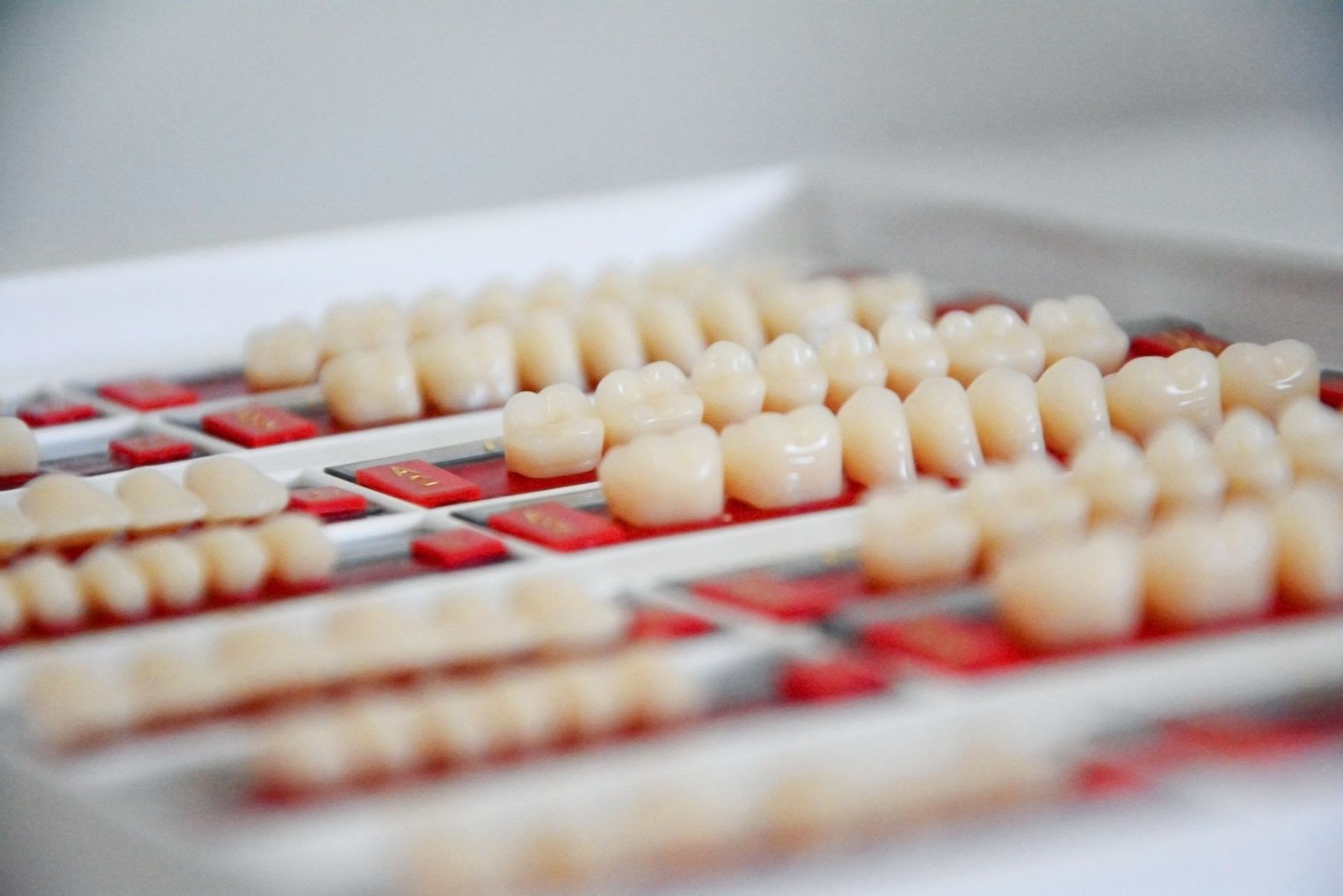
A dental crown covers the decaying and damaged teeth of an individual. It is placed over a dental implant to revive the functions of a missing tooth. Dental implants are fittings made from metal attached to your jawbone. These dental implants fasten to your jawbone as the bone fuses the metal. This process is known as osseointegration. The crown is the visible part of the implant that resembles your natural teeth. The crown and the implants are connected through a piece known as an abutment. This process of installing dental implants takes from six to twelve weeks. Dental implants and crowns provide sturdy support to your jaw while you eat. Capping weak, damaged, or decaying teeth helps maintain your teeth' shape and size.
Who needs a dental crown?
- Depending on your oral condition and requirement, you might need a dental crown for the following reasons.
- You are suffering from tooth decay and want to protect your teeth from worsening further. A dental crown protects your weak tooth and prevents it from cracking.
- You have a tooth that is worn out, and it is troubling you. Broken and worn-out teeth keep you from chewing and eating your food properly. A dental cap restores the functions of a broken tooth.
- You have a tooth with a large filling. With a dental crown, you can cover and support a tooth that doesn't have many parts of it left.
- You are getting dental bridges. When dental bridges are fixed with implants, the crown sits on the top as the visible part and resembles the shape and structure of your natural teeth.
- You have a tooth that doesn't look good. Crowns can cover the teeth that are distorted or severely stained due to your lifestyle and habits. This enhances your smile.
- You have undergone the process of installing dental implants. Since the implant consists of a titanium rod that protrudes from the gumline, it might not look usual. A crown covers the dental implant and makes your teeth look natural when you speak or smile.
- You have undergone a root canal. A crown covering the tooth with a root canal protects and prevents fracture. The original tooth, which is shorter, remains under the crown, and you can eat as per your wish.
Types Of Dental Crowns
When you think of getting a dental crown, one major question that lingers is what type of dental crown you should get. Depending on the material, procedure, and the need of patients, there are several types of crowns available. You can choose any of the following five types of dental crowns.
Gold Crown
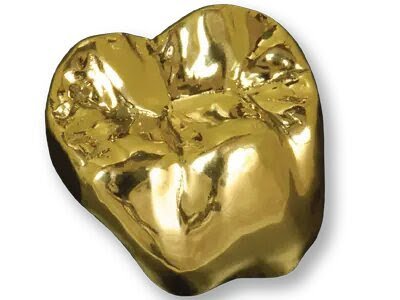
Gold crowns combine noble metals such as gold, silver, and platinum. They can also be of base metal alloys such as nickel-chromium. The main benefit of getting a gold crown is they are strong and durable. They stay for a long time if you care for them properly. With gold crowns, less portion of the tooth requires removal. Similar to the natural enamel of your teeth, the gold crowns wear off slowly.
Dentists may suggest a gold crown for restoring the teeth on the back, molars, and premolars. But they are only sometimes the first choice of people. As they are made out of metal, the gold crowns don't resemble your natural teeth, resulting in poor aesthetics.
And since metal is a conductor of heat, it may result in sensitivity, swelling, and allergic reactions.
Porcelain Crowns
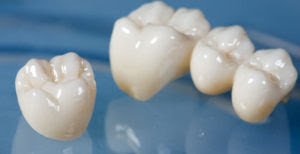
It is one of the most common dental crowns and is widely used nowadays. It is completely made out of porcelain material or ceramic. Such crowns match the shape, size, and color of your surrounding teeth, giving you the most natural look. Since no material is used in these porcelain crowns, they are biocompatible and toxic-free. Porcelain crowns are more costly than metal crowns but are less strong than them. For your porcelain crown to last longer, you should take care of your crown well.
Porcelain fused to metal crowns
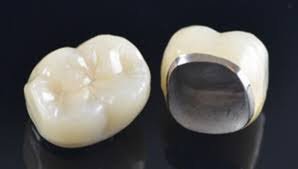
Such types of crowns offer a combination of durability and aesthetics. This type of crown is made of a metal structure that provides strength. This structure is coated with a layer of porcelain that makes the crown look like natural teeth. The porcelain fused with metal crowns has been widely used for over 50 years. They work well and cost comparatively less than all-porcelain crowns.
However, this type of crown is only suitable for some people who tense their teeth. It may wear down with the pressure from the opposite teeth. Moreover, the metal part of these crowns may cause a gray line at the base of the gums. These may not be as aesthetically pleasing as all-porcelain crowns.
Zirconia Crowns

A relatively new material, Zirconia crowns are stronger than conventional metal crowns and provide the aesthetic of porcelain. Since they are strong and durable, they are less likely to chip and break. Creating Zirconia crowns consumes less time as its cutting and shaping can be done at the same place. The best thing about Zirconia crowns is that they are biocompatible. They don't cause harm to the nearby tissue. Hence, they don't cause allergic reactions.
Lithium Disilicate Crowns
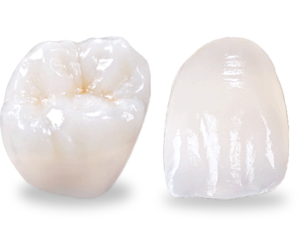
The Lithium Disilicate Crowns, also known as E-Max, are the newest type of crowns. It is an all-ceramic crown that is thin and light. They look great in your mouth and are very strong and durable. Though they can be more expensive, the Lithium disilicate crowns provide an excellent option for the crowns of both front and back teeth.
Stainless Steel Crowns
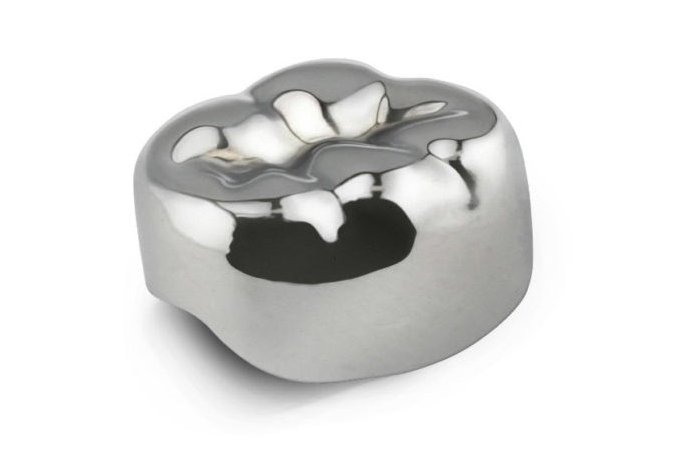
These crowns are prefabricated ones used on permanent teeth for a temporary purpose. Such a crown protects your tooth while your permanent crown made from other material is under creation. The stainless steel crown is usually used for children to fit over a primary tooth. It covers the tooth entirely and stops it from decaying further. When a child's baby teeth start to fall, the stainless steel crown comes out naturally. Such crowns are used for children's teeth because they don't have to visit the dentist repeatedly for fitting. Hence, stainless steel crowns are more cost-effective and protect children's oral health.
Partial Crowns
What if you have a tooth that is not too damaged to fear a full dental crown but can't be cured by just a filing? Reshaping requires filing the top of the tooth to place the crown on the top. However, the filling can damage the remaining healthy structure if one doesn't need a complete crown. Also, a decayed tooth with a large dental filling makes the tooth prone to fractures and worsens the conditions for the future. In such situations, the tooth is restored with an Onlay.
An Onlay is a custom-made restoration that only covers the tooth at only some points. Hence, they are also known as partial crowns. They enable the restoration of large cavities while preserving natural tooth structure as much as possible. Onlays are generally made out of metals, resin material, or porcelain and are created to match the color of your natural tooth.
Depending on the method of creation, the onlays are of two types.
Indirect Onlays
Indirect Onlays are made from porcelain and created in a dental laboratory. It requires two dental appointments to get Indirect only. At the first appointment, the dentist takes the impression of your tooth and sends it to the dental technician. While your indirect Onlay is in creation, the dentist will provide you with a temporary filling. On your second dental visit, you will get the temporary filling removed, and the dentist will cement the permanent onlay on your tooth.
Direct Onlays
Direct onlays are made at the dental clinic, and their installation is completed in a single day. Such types of Onlays are made out of resins or ceramic. Earlier the direct Onlays were created with a mold. Then, the crown material was poured into a mold, hardened in an oven, and finally attached to the tooth with cement. But now, this process is done through CAD/CAM (Computer-Aided Design and Manufacturing.) Therefore, you will only need a single appointment with your dentist to get direct Onlays.
There is another kind of restoration similar to an Onlay. It is known as an inlay. The inlays cover different areas of a tooth. The difference between Onlay and inlay is that the former fills the middle area and the outer spaces used in chewing. In comparison, an inlay fills only the middle of a tooth. Depending on your oral health and the extent of decay in your tooth, you may receive an Onlay or inlay.
Procedure For Dental Crown

Assessment and Impressions
On your first visit to get the crown, the dentist will assess your oral condition and check for any signs of decay and damage. X-Ray and scanning enable the dentist to examine factors that can lead to infection and worsen the condition further. In case of severe tooth decay, you may undergo root canal treatment before installing the crown.
The dentist will reshape your tooth, so there is space for the crown. The extent of filing and reshaping the tooth structure depends on the type of dental crown you're getting. If you choose a metal crown, less tooth needs to be removed than a porcelain crown. As per the shape of the crown, your tooth structure is filed from the top and the sides. There might be a case in which the patient may have insufficient tooth structure due to severe tooth decay. In such situations, the tooth's structure is built with a filling material so the crown can rest on it.
After shaping the crown, the next step is taking an impression of the filed tooth. This impression helps the dentist create a crown that can fit the tooth as closely as possible. The dentists also take an impression of the tooth on the opposite jaw and will join with the crown when the patient bites. Again, it ensures that the new crown fits perfectly with the opposite side of the jaw and the adjacent teeth.
Dentists generally use putty or a paste that can hold the shape of impressions of the tooth. This material is spread over the reshaped tooth and then removed while maintaining its shape. At this stage, your dentist also notes the details about the tooth that affect the king of the crown, such as color and structure. The crown's color should resemble that of the tooth and the surrounding teeth.
The impressions of your teeth are sent to the dental technician who created your crown. In the meantime, the dentist will place a temporary crown on the tooth to protect it while your permanent crown gets ready. When you visit your dentist to get your final crown, they will remove your temporary crown first.
Permanent Crown Placement
Once your crown is ready, it's time for your next visit to the dental clinic. First, you will get your temporary crown removed. Then the dentist fits your permanent crown on the tooth. The whole process of installing the crown and ensuring proper fitting may take up to three weeks.
Once your crown is ready, it's time for your next visit to the dental clinic. First, you will get your temporary crown removed. Then the dentist fits your permanent crown on the tooth. The whole process of installing the crown and ensuring proper fitting may take up to three weeks.Before cementing the crown on the tooth, it is crucial to ensure that it is perfectly made and resembles your natural teeth in shape, color, and structure. The dentists usually provide local anesthetics while installing the crown to numb the area and reduce the discomfort. Then the crown is fixed over the tooth with dental cement. The dentists may make minor adjustments to the crown's structure to ensure no problem while you bite and eat.
Same-day Crown Placement
In some cases, the crowns are constructed at the dental clinic. Then, with no need to send the impressions to the dental laboratory, the crown can be placed on the patient's tooth on the same day.
For same-day crown placement, instead of taking the impression of the tooth, the pictures are taken by a scanner known as a wand. After uploading to the computer software, these images create a 3D model of the teeth. This digital model can create a ceramic crown on the same day. This method of creating crowns through computer software is known as Computer-Aided Design. This process can create crowns in as quick as fifteen minutes.
Maintenance And Aftercare
Once you get your crowns, it is equally important to care for them. It ensures that your crown doesn't get damaged and lasts for a long. Here is how you can care for your temporary and permanent crown.
Temporary Crown
A temporary crown is a cap that the dentists place on your tooth when your permanent tooth is in the making. It is essential to care for your temporary tooth crown and preserve it until you get your permanent crown. Though you will wear a temporary crown for only two to three weeks, you should keep it safe. Avoid consuming chewy food items such as chewing gums and candies. You should also avoid eating hard food such as fruits and nuts. Try to minimize your biting Force and eat from the other side of your mouth, so your crown doesn't break. It would be best to ignore your dental hygiene while wearing temporary crowns. Clean your gums regularly and massage them with your fingers. While using dental floss, be careful not to lift it out with Force. If your temporary crown breaks, contact your dentist as soon as possible.
Permanent Crown
You should avoid eating hard, chewy, and sticky food items during the first few days after getting the permanent dental crown. Take care while brushing and flossing your teeth, and rinse your mouth with salty warm water. Do not eat or drink anything while you're under local anesthesia. While taking care of your permanent crown, you should consider the following points:
1. Bite Force
Since crowns are not as strong as natural teeth, you should avoid biting your nails and other complex objects. This may damage the crown. Other things that may risk the crown are bruxism or grinding of teeth. If you have such a condition, your doctor may prescribe a night card for sleeping. You should also avoid activities or sports that may result in stress as they may cause you to clench your teeth. You can wear mouthguards to protect your teeth and crown during sports.
2. Dental Hygiene
An advantage of crowns is that they are made of ceramic material or a mixture of metals. Hence, they don't develop stains or plaque. But cavities can develop at the edge of the crown, where it meets the natural tooth. It would be best to clean this edge thoroughly to prevent your teeth from decaying. In addition, you should brush your teeth twice daily with fluoride toothpaste and floss them to remove plaque. If your teeth are prone to develop cavities, your dentist may prescribe a fluoride-rich gel to use at night.
Dental Crowns Specialist In NJ
You might need clarification about the type of dental crown you should get. Also, getting a root canal, filling your tooth, and getting a crown may make you anxious. It is normal to feel so. However, the best solution to overcome dental anxiety and realize your dental requirement is to talk to your dentist. An experienced dentist understands your situation and makes the process easier for you. Ask your dentist about the whole process and know everything in advance. In this way, you will remain calm throughout the procedure. Finding a dental clinic where you feel comfortable can change the whole game for you.
At Jackson Dental, we have a comfortable environment and a highly skilled team that provides you with the best oral health services. We understand that the thought of getting a crown for your tooth can make you feel anxious. With expertise in cosmetic dentistry, you get the most effective and precise dental solutions to your problem. At Jackson Dental, you experience patient-centric care right from the first consultation. Whether you plan to get implant-supported crowns or Onlays, Jackson Dental is a one-stop solution to all your dental requirements.
Conclusion
A dental crown restoring the functions of your missing tooth won't even make you feel it is unnatural. From biting to chewing and from speaking to smiling, you can do all of it! Earlier, the installation of crowns required 2-3 weeks. But today, with technological advancements, you can get your crown in just a day. Computer Software and 3D scanners have changed the game. No matter what kind of dental crown you get, it will enhance your oral health and stop your teeth from decaying further. Moreover, your aesthetics would remain the same. If you are suffering from tooth decay, a crown will protect it from spreading and safeguard your smile.